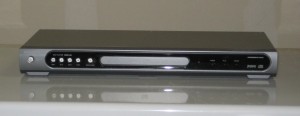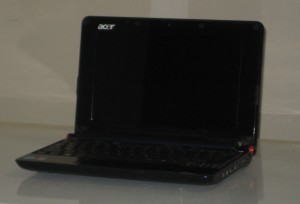Potential: Super Box
[Strong Bad’s e-mail has undergone a tremendous Interface Screw, and the screen on his computer has literally drained all of its content onto the floor.]
Homestar: Never fear, Strong Bad! I know how to fix your computer box.
Strong Bad: No, no, don’t touch that!
Homestar: Your super box needs words.
— sbemail 118
While cleaning up for an event at my house yesterday, I happened upon the lifeless husk of a DVD player that was ruined by a lightning strike just over a year ago.
Today being my day off, I took it apart just to see what might be salvageable. Granted, the defibrillation it took probably derated most or all of its electronic components, but perhaps some of the switches and connectors came through intact. While I was taking it apart, it occurred to me that its most attractive feature would have been untouched by the strike: Its case. On the front, it has a panel of six tactile buttons on a breakout board (if they were damaged, they’re a common style that’s easily replaced), three optic pipes on the right for PCB-mounted status LEDs, a transparent area for an IR receiver, and the tray door, which is spring-biased closed by default. On the back, there is a place for a power cord and an array of analog AV connectors (RCA and S-video). And, of course, the form factor is worth noting: It’s the size and shape of a DVD player, and as such would be a good fit for a set-top box.
Now, what could I put in that box to make it useful? One possibility would be the vastly underused Acer Aspire One I bought two and a half years ago.
This computer has served me nicely on a few rare occasions that I’ve needed a computer without expecting to. However, it would have been a better fit for my previous life in DC, and most uses I had for it have fallen onto the Droid I started carrying for work. It’s no powerhouse; you’d be hard-pressed to run any particularly impressive graphics on it, or even complex Flash movies. But it runs Ubuntu, it can do YouTube, it’s adequate with emulators, and it can reportedly even run MythTV (think tinkerer-friendly TiVo). As far as I know, it doesn’t have TV in or out, but it has a DE-15F VGA connector, and my current TV (which replaced a TV that was zapped in the aforementioned incident) happens to have VGA in. Nice. The computer is easy on both power and ventilation requirements, and, well, it’s a netbook—the guts are small enough to be mounted in a wide variety of alternative cases.
This being an interesting place to have a computer, it would have to have a variety of interesting interfaces. The Acer already does wi-fi, and that’s a very good start. There’s a place for a IR receiver, and that would definitely be a must; LIRC would be the jumping-off point there.
Aside from that, you may have noticed that I’ve been writing a lot lately about game controller interfaces. I’ve been turning over in my head the possibility of a DE-9M gameport that is electrically compatible with controllers for Sega (Genesis), Nintendo (NES, SNES, N64, GameCube), and Sony (PS, PS2), with firmware extensible to more designs as necessary. It would be possible to connect a Sega controller directly; all of the others would utilize an almost-passive[1] adapter. DE-9 connectors are compact (most of the aforementioned controller connectors are huge by comparison) and very easy to source and replace.
Using a single connector on the console end instead of a smattering[2] simplifies the wiring and the board design while offloading the hairy details to external adapters. This last point is important because it’s tricky to find many controller connectors in panel-mount forms[3], but extension cables are common as accessories, usually not as tricky to source.
So, folks, interesting possibilities!
- [1]Adapters for non-Sega controllers would contain circuitry to identify which alternate configuration it should use, probably as simple as a transistor and two resistors totaling less than a quarter in parts.↩
- [2]The RetroN 3 takes this approach, with two ports and a cartridge slot each for three different systems.↩
- [3]I’ve actually made panel-mount PS controller ports using extension cables, metal L-shapes, and a generous application of epoxy. Didn’t turn out too badly, either.↩

